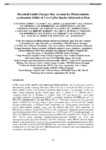Use este identificador para citar ou linkar para este item:
http://www.alice.cnptia.embrapa.br/alice/handle/doc/1035417Registro completo de metadados
| Campo DC | Valor | Idioma |
|---|---|---|
| dc.contributor.author | SCOTTI-CAMPOS, P. | pt_BR |
| dc.contributor.author | PAIS, I. P. | pt_BR |
| dc.contributor.author | LIDON, F. C. | pt_BR |
| dc.contributor.author | MARTINS, L. A. | pt_BR |
| dc.contributor.author | TOMAZ, M. A. | pt_BR |
| dc.contributor.author | SEMEDO, J. N. | pt_BR |
| dc.contributor.author | RODRIGUES, A. P. | pt_BR |
| dc.contributor.author | FORTUNATO, A. S. | pt_BR |
| dc.contributor.author | PALOS, I. | pt_BR |
| dc.contributor.author | BATISTA-SANTOS, P. | pt_BR |
| dc.contributor.author | LEITÃO, A. E. | pt_BR |
| dc.contributor.author | LOPES, E. | pt_BR |
| dc.contributor.author | SIMÕES-COSTA, M. C. | pt_BR |
| dc.contributor.author | GOULÃO, L. | pt_BR |
| dc.contributor.author | RIBEIRO-BARROS, A. I. | pt_BR |
| dc.contributor.author | SILVA, M. J. | pt_BR |
| dc.contributor.author | MAIA, R. | pt_BR |
| dc.contributor.author | MÁGUAS, C. | pt_BR |
| dc.contributor.author | REBOREDO, F. H. | pt_BR |
| dc.contributor.author | PESSOA, M. F. | pt_BR |
| dc.contributor.author | morais, l. e. | pt_BR |
| dc.contributor.author | SANGLARD, L. M. V. | pt_BR |
| dc.contributor.author | ARAÚJO, W. L. | pt_BR |
| dc.contributor.author | GHINI, R. | pt_BR |
| dc.contributor.author | DaMATTA, F. M. | pt_BR |
| dc.contributor.author | RAMALHO, J. C. | pt_BR |
| dc.date.accessioned | 2016-01-28T11:11:11Z | pt_BR |
| dc.date.available | 2016-01-28T11:11:11Z | pt_BR |
| dc.date.created | 2016-01-28 | pt_BR |
| dc.date.issued | 2014 | pt_BR |
| dc.identifier.citation | In: INTERNATIONAL CONFERENCE ON COFFEE SCIENCE, 25., 2014, Armenia. Leveraging knowledge for coffee sustainability: proceedings. Armenia: Association for Science and Information on Coffee, 2014. p. 42-47. | pt_BR |
| dc.identifier.uri | http://www.alice.cnptia.embrapa.br/alice/handle/doc/1035417 | pt_BR |
| dc.description | Summary: Coffee is one of the world?s most traded agricultural products, and its production could be threatened by global warming. The aim of this work was to evaluate the effects of heat on photosynthetic activity and thylakoid membrane lipid dynamics, on genotypes of the two major coffee producing species. Potted plants from C. arabica L. cv. IPR108 and C. canephora Pierre Ex A. Froehner cv. Conilon Clone 153 were grown for 1 year under controlled conditions of temperature (25/20ºC, day/night), irradiance (650-800 ?mol m-2 s-1), RH (75%), photoperiod (12 h), and 380 ?L CO2 L-1. Thereafter, temperature was gradually raised to 42/34ºC (0.5ºC/ day), with a 7 days stabilization step at 31, 37 and 42ºC. Studies focused modifications of thylakoid lipid composition and photosynthetic performance. In CL153 photosynthetic capacity (Amax) was not affected until 42ºC (40% reduction). In IPR108 it was reduced 35 and 57% at 37ºC at 42ºC, respectively. Thylakoid electron transport rate for photosystems (PS) I and II increased (ca. 10-25%) up to 37ºC in both genotypes. At 42ºC only IPR108 presented depressed activities on PSII (15%) and PSI (18%). Under 37 and 42ºC, CL153 plants presented digalactosyldiacylglycerol (DGDG) (ca. 42%) and monogalactosyldiacylglycerol (MGDG) (28-34%) increases, while IPR108 showed higher MGDG at all temperatures. In CL153 less unsaturated DGDG and phosphatidylglycerol (PG) along with stable or increased DGDG/MGDG ratio, may have contributed to sustain thylakoid electron flow at 37ºC and even 42ºC. IPR108 displayed a strong PG rise at all temperatures, in accordance with enhanced PSs activity. | pt_BR |
| dc.language.iso | eng | eng |
| dc.rights | openAccess | eng |
| dc.title | Thylakoid lipids changes may account for photosynthetic acclimation ability of two coffea species subjected to heat. | pt_BR |
| dc.type | Artigo em anais e proceedings | pt_BR |
| dc.date.updated | 2016-01-28T11:11:11Z | pt_BR |
| dc.subject.thesagro | Café | pt_BR |
| dc.subject.thesagro | Aclimatação | pt_BR |
| dc.subject.thesagro | Clima | pt_BR |
| dc.subject.thesagro | Coffea arabica | pt_BR |
| dc.subject.thesagro | Dióxido de carbono | pt_BR |
| dc.subject.thesagro | Temperatura | pt_BR |
| dc.subject.thesagro | Fotossíntese | pt_BR |
| dc.subject.nalthesaurus | Carbon dioxide | pt_BR |
| dc.subject.nalthesaurus | Climate change | pt_BR |
| dc.subject.nalthesaurus | Temperature | pt_BR |
| dc.subject.nalthesaurus | Photosynthesis | pt_BR |
| dc.subject.nalthesaurus | Thylakoids | pt_BR |
| riaa.ainfo.id | 1035417 | pt_BR |
| riaa.ainfo.lastupdate | 2016-01-28 | pt_BR |
| dc.contributor.institution | PAULA SCOTTI-CAMPOS, Instituto Nacional Investigação Agrária e Veterinária; ISABEL P PAIS, Instituto Nacional Investigação Agrária e Veterinária; FERNANDO C LIDON, Universidade Nova de Lisboa; LIMA D MARTINS, Instituto Investigação Científica Tropical; MARCELO ANTONIO TOMAZ, UFES; JOSE NOBRE SEMEDO, Instituto Nacional Investigação Agrária e Veterinária; ANA PAULA RODRIGUES, Universidade de Lisboa; ANA S FORTUNATO, Instituto Investigação Científica Tropical; I PALOS, Instituto Investigação Científica Tropical; PAULA BATISTA-SANTOS, Instituto Investigação Científica Tropical; ANTONIO E LEITAO, Instituto Investigação Científica Tropical; E LOPES, Instituto Investigação Científica Tropical; MARIA CRISTINA SIMÕES-COSTA, Instituto Investigação Científica Tropical; LUIS GOULAO, Instituto Investigação Científica Tropical; ANA I RIBEIRO-BARROS, Instituto Investigação Científica Tropical; M J SILVA, Instituto Investigação Científica Tropical; R MAIA, Universidade de Lisboa; CRISTINA MAGUAS, Universidade de Lisboa; FERNANDO H REBOREDO, Universidade Nova de Lisboa; M F PESSOA, Universidade Nova de Lisboa; LEANDRO ELIAS MORAIS, UFV; LILIAN MARIA VINCIS PEREIRA SANGLARD, UFV; WAGNER L ARAUJO, UFV; RAQUEL GHINI, CNPMA; FABIO MURILO DAMATTA, UFV; JOSE C RAMALHO, Instituto Investigação Científica Tropical. | pt_BR |
| Aparece nas coleções: | Artigo em anais de congresso (CNPMA)  | |
Arquivos associados a este item:
| Arquivo | Descrição | Tamanho | Formato | |
|---|---|---|---|---|
| 2015AA014.pdf | 336 kB | Adobe PDF |  Visualizar/Abrir |









